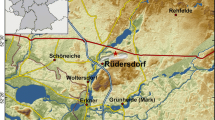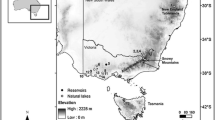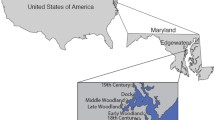Abstract
Several techniques are available to examine the isotopic composition of historic lake waters, providing data that can subsequently be used to examine environmental changes. A recently-developed technique is the stable oxygen isotope analysis of subfossil chironomid (Diptera: Chironomidae) head capsules (mostly chitin) preserved in lake sediments. This technique involves a high Temperature Conversion Elemental Analyzer (TC/EA), which has been a relatively recent addition to the suite of online peripherals for analyzing the stable isotopic composition of organic samples. The highly precise and accurate 18O/16O and D/H measurements obtainable using the TC/EA with samples in the microgram range make this instrumentation suitable for studying geochemical and biological processes. Preparation of organic samples for isotopic analysis typically requires first weighing each sample into silver/tin capsules. These capsules can introduce oxygen and hydrogen contamination (a “blank effect”), which is especially problematic for analysis of small organic samples (e.g. less than 100 μg). Here we tested tin and silver capsules from two manufacturers and a range of sizes to assess contamination to small organic samples on the TC/EA. We also assessed how a method for cleaning silver capsules affected our analysis of commercial chitin. In general, capsules made of silver have less detectible oxygen than those made of tin, and capsules from the two manufacturers varied in their detectible oxygen. There was no detectable H contamination from silver capsules. In addition to our empirical findings, we present a model demonstrating the influence that contaminant oxygen can have on the δ18O of small organic samples. Sample mass becomes an important issue for such analyses. In light of our findings, we recommend a minimum sample mass ≥50 μg (approximately 120 whole chironomid head capsules) on a TC/EA-IRMS (Deltaplus XP system). Finally, we present a detailed protocol for preparing and transferring chironomid head capsules into silver capsules that minimizes the influence of contaminant oxygen. This protocol provides the paleo-community with another potential method for reconstructing paleoenvironments.




Similar content being viewed by others
References
Anderson L, Abbott MB, Finney BP (2001) Holocene climate inferred from oxygen isotope ratios in lake sediments, central Brooks Range, Alaska. Quatern Res 55:313–321
Bowen GJ, Chesson L, Nielson K, Cerling TE., Ehleringer JR (2005) Treatment methods for the determination of delta H-2 and delta O-18 of hair keratin by continuous-flow isotope-ratio mass spectrometry. Rapid Commun Mass Spectrom 19:2371–2378
Farquhar GD, Henry BK, Styles JM (1997) A rapid on-line technique for determination of oxygen isotope composition of nitrogen-containing organic matter and water. Rapid Commun Mass Spectrom 11:1554–1560
Gannes LZ, O’Brien DM, delRio CM (1997) Stable isotopes in animal ecology: Assumptions, caveats, and a call for more laboratory experiments. Ecology 78:1271–1276
Gannon JE (1971) Two counting cells for the enumeration of zooplankton micro-crustacea. Trans Am Microsc Soc 90:486–490
Grocke DR, Schimmelmann A, Elias S, Miller RF (2006) Stable hydrogen-isotope ratios in beetle chitin: preliminary European data and re-interpretation of North American data. Quat Sci Rev 25:1850–1864
Hu FS, Kaufman D, Yoneji S, Nelson D, Shemesh A, Huang Y, Tian J, Bond G, Clegg B, Brown T (2003) Cyclic variation and solar forcing of Holocene climate in the Alaskan subarctic. Science 301:1890–1893
Huang YS, Shuman B, Wang Y, Webb T (2004) Hydrogen isotope ratios of individual lipids in Lake sediments as noval traces of climatic and environmental change: a surface sediment test. J Paleolimnol 31:363–375
ISOGEOCHEM Listserv archive (7/19/2006) Discussion on Silver/tin capsules on TC/EA, http://list.uvm.edu/cgi-bin/wa?A2=ind0607&L=ISOGEOCHEM&P=R9033&m=10516; Item number 014851-014857. Last accessed on September 24th 2007
ISOGEOCHEM Listserv archive (7/21/2006) Discussion on Silver/tin capsules on TC/EA, http://list.uvm.edu/cgi-bin/wa?A2=ind0607&L=ISOGEOCHEM&P=R10325&X=114D1F48358F04D4B1&Y=ftyw%40uaf.edu&m=14625; Item number 014870. Last accessed on September 24th 2007
Kelly SD, Parker IG, Sharman M, Dennis MJ (1998) On-line quantitative determination of H-2/H-1 isotope ratios in organic and water samples using an elemental analyzer coupled to an isotope ratio mass spectrometer. J Mass Spectrom 33:735–738
Kornexl BE, Gehre M, Hofling R, Werner RA (1999a) On-line delta O-18 measurement of organic and inorganic substances. Rapid Commun Mass Spectrom 13:1685–1693
Kornexl BE, Werner RA, Gehre M (1999b) Standardization for oxygen isotope ratio measurement – still an unsolved problem. Rapid Commun Mass Spectrom 13:1248–1251
Koziet J (1997) Isotope ratio mass spectrometric method for the on-line determination of oxygen-18 in organic matter. J Mass Spectrom 32:103–108
Kreuzer-Martin HW, Lott MJ, Dorigan J, Ehleringer JR (2003) Microbe forensics: Oxygen and hydrogen stable isotope ratios in Bacillus subtilis cells and spores. Proc Natl Acad Sci USA 100:815–819
Lamb AL, Leng MJ, Mohammed MU, Lamb HF (2004) Holocene climate and vegetation change in the Main Ethiopian Rift Valley, inferred from the composition (C/N and delta C-13) of lacustrine organic matter. Quat Sci Rev 23:881–891
Lamb AL, Leng MJ, Sloane HJ, Telford RJ (2005) A comparison of the palaeoclimate signals from diatom oxygen isotope ratios and carbonate oxygen isotope ratios from a low latitude crater lake. Palaeogeogr Palaeoclimatol Palaeoecol 223:290–302
Leng MJ, Barker PA (2006) A review of the oxygen isotope composition of lacustrine diatom silica for palaeoclimate reconstruction. Earth Sci Rev 75:5–27
Miller RF (1991) Chitin Paleoecology. Biochem Syst Ecol 19:401–411
Miller RF, Vossfoucart MF, Toussaint C, Jeuniaux C (1993) Chitin preservation in quaternary coleoptera—preliminary-results. Palaeogeogr Palaeoclimatol Palaeoecol 103:133–140
Sauer PE, Miller GH, Overpeck JT (2001) Oxygen isotope ratios of organic matter in arctic lakes as a paleoclimate proxy: field and laboratory investigations. J Paleolimnol 25:43–64
Schimmelmann A, DeNiro MJ (1986a) Stable isotopic studies on chitin, measurements on chitin/chitosan isolates and D-glucosamine hydrochloride from chitin. In: Muzzarelli RA, Jeuniaux AC, Gooday GW (eds) Chitin in nature and technology. Plenum Publishing Corporation, New York, pp 357–364
Sharp ZD, Atudorei V, Durakiewicz T (2001) A rapid method for determination of hydrogen and oxygen isotope ratios from water and hydrous minerals. Chem Geol 178:197–210
Walker IR (2001) Midges: Chironomidae and related diptera. In: Smol JP, Birks HJB, Last WM (eds) Tracking environmental change using lake sediments (Zoological indicators), vol 4. Kluwer Academic Publishers, Dordrecht, The Netherlands, pp 43–66
Wassenaar LI, Hobson KA (2002) Comparative equilibration and online technique for determination of non-exchangeable hydrogen of keratins for use in animal migration studies. Isotopes Environ Health Stud 39:211–217
Werner RA (2003) The online O-18/O-16 analysis: development and application. Isotopes Environ Health Stud 39:85–104
Werner RA, Brand WA (2001) Referencing strategies and techniques in stable isotope ratio analysis. Rapid Commun Mass Spectrom 15:501–519
Werner RA, Kornexl BE, Rossmann A, Schmidt HL (1996) On-line determination of delta O-18 values of organic substances. Anal Chim Acta 319:159–164
Wolfe BB, Edwards TWD, Aravena R, Forman SL, Warner BG, Velichko AA, MacDonald GM (2000) Holocene paleohydrology and paleoclimate at treeline, north-central Russia, inferred from oxygen isotope records in lake sediment cellulose. Quat Res 53:319–329
Wolfe BB, Edwards TWD, Elgood RJ, Beuning KR (2001) Carbon and oxygen isotope analysis of lake sediment cellulose: methods and applications. In: Last WM. Smol JP (eds) Tracking Environmental change using lake sediments (Physical and chemical techniques), vol 2. Kluwer Academic Publishers, Dordrecht, The Netherlands, pp 1–28
Wolfe BB, Falcone MD, Clogg-Wright KP, Mongeon CL, Yi Y, Brock BE, Amour NAS, Mark WA, Edwards TWD (2007) Progress in isotope paleohydrology using lake sediment cellulose. J Paleolimnol 37:221–231
Wooller MJ, Francis DR, Fogel ML, Miller GH, Walker IR, Wolfe AP (2004) Quantitative paleotemperature estimates from delta O-18 of chironomid head capsules preserved in arctic lake sediments. J Paleolimnol 31:267–274
Wooller MJ, Wang Y, Axford Y (2007) A multiple stable isotope record of Late Quaternary limnological changes and chironomid paleoecology from northeastern Iceland. J Paleolimnol, doi:10.1007/s10933-007-9144-8
Acknowledgements
This research was supported by the National Science Foundation (NSF ESH-0317766 to Wooller) and the Alaska Stable Isotope Facility (ASIF) at the University of Alaska Fairbanks. The authors thank ASIF colleagues Tim Howe and Norma Haubenstock for their diligent work and valuable comments for experimental design and suggestions. We are grateful to participants and organizers, especially Dr. Ian Walker and Dr. Pete Landgon, at the international “Dead midges 2005 workshop” for stimulating encouragement for stable isotope applications on chironomid fossil heads. Thanks also to Dr. Yarrow Axford and Dr. Gifford Miller from the Institute for Arctic and Alpine Research (INSTAAR), Boulder, Colorado for valuable comments and support for method development in the early stages. We also thank Lena Krutikov and two anonymous reviewers for their constructive reviews of our paper.
Author information
Authors and Affiliations
Corresponding author
Rights and permissions
About this article
Cite this article
Wang, Y., Francis, D.R., O’Brien, D.M. et al. A protocol for preparing subfossil chironomid head capsules (Diptera: Chironomidae) for stable isotope analysis in paleoclimate reconstruction and considerations of contamination sources. J Paleolimnol 40, 771–781 (2008). https://doi.org/10.1007/s10933-008-9197-3
Received:
Accepted:
Published:
Issue Date:
DOI: https://doi.org/10.1007/s10933-008-9197-3




